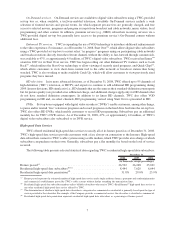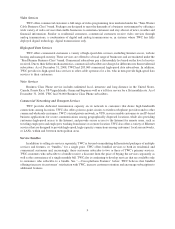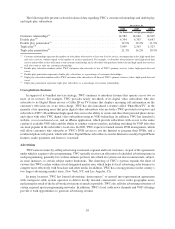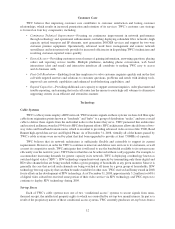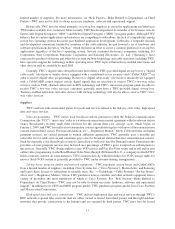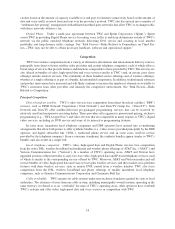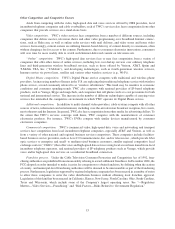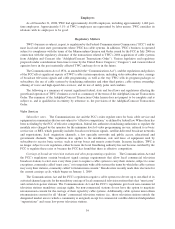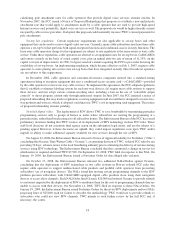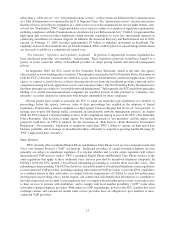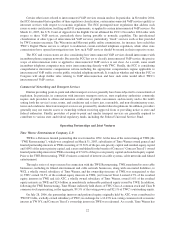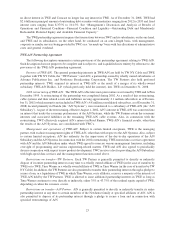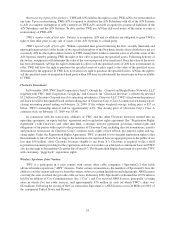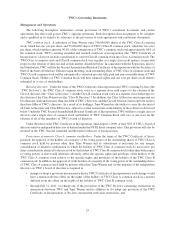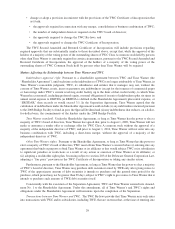Time Warner Cable 2008 Annual Report Download - page 26
Download and view the complete annual report
Please find page 26 of the 2008 Time Warner Cable annual report below. You can navigate through the pages in the report by either clicking on the pages listed below, or by using the keyword search tool below to find specific information within the annual report.Employees
As of December 31, 2008, TWC had approximately 46,600 employees, including approximately 1,460 part-
time employees. Approximately 5.1% of TWC’s employees are represented by labor unions. TWC considers its
relations with its employees to be good.
Regulatory Matters
TWC’s business is subject, in part, to regulation by the Federal Communications Commission (“FCC”) and by
most local and some state governments where TWC has cable systems. In addition, TWC’s business is operated
subject to compliance with the terms of the Memorandum Opinion and Order issued by the FCC in July 2006 in
connection with the regulatory clearance of the transactions related to TWC’s 2006 acquisition of cable systems
from Adelphia and Comcast (the “Adelphia/Comcast Transactions Order”). Various legislative and regulatory
proposals under consideration from time to time by the United States Congress (“Congress”) and various federal
agencies have in the past materially affected TWC and may do so in the future.
The Communications Act of 1934, as amended (the “Communications Act”), and the regulations and policies
of the FCC affect significant aspects of TWC’s cable system operations, including video subscriber rates; carriage
of broadcast television signals and cable programming, as well as the way TWC sells its program packages to
subscribers; the use of cable systems by franchising authorities and other third parties; cable system ownership;
offering of voice and high-speed data services; and its use of utility poles and conduits.
The following is a summary of current significant federal, state and local laws and regulations affecting the
growth and operation of TWC’s business as well as a summary of the terms of the Adelphia/Comcast Transactions
Order. The summary of the Adelphia/Comcast Transactions Order herein does not purport to be complete and is
subject to, and is qualified in its entirety by reference to, the provisions of the Adelphia/Comcast Transactions
Order.
Video Services
Subscriber rates. The Communications Act and the FCC’s rules regulate rates for basic cable service and
equipment in communities that are not subject to “effective competition,” as defined by federal law. Where there has
been no finding by the FCC of effective competition, federal law authorizes franchising authorities to regulate the
monthly rates charged by the operator for the minimum level of video programming service, referred to as basic
service tier or BST, which generally includes broadcast television signals, satellite-delivered broadcast networks
and superstations, local origination channels, a few specialty networks and public access, educational and
government channels. This regulation also applies to the installation, sale and lease of equipment used by
subscribers to receive basic service, such as set-top boxes and remote control units. In many localities, TWC is
no longer subject to rate regulation, either because the local franchising authority has not become certified by the
FCC to regulate these rates or because the FCC has found that there is effective competition.
Carriage of broadcast television stations and other programming regulation. The Communications Act and
the FCC’s regulations contain broadcast signal carriage requirements that allow local commercial television
broadcast stations to elect once every three years to require a cable system to carry their stations, subject to some
exceptions, commonly called “must carry,” or to negotiate with cable systems the terms by which the cable systems
may carry their stations, commonly called “retransmission consent.” Broadcasters recently made their elections for
the current carriage cycle, which began on January 1, 2009.
The Communications Act and the FCC’s regulations require a cable operator to devote up to one-third of its
activated channel capacity for the mandatory carriage of local commercial television stations that elect “must carry”
and certain low-power stations. The Communications Act and the FCC’s regulations give local non-commercial
television stations mandatory carriage rights, but non-commercial stations do not have the option to negotiate
retransmission consent for the carriage of their signals by cable systems. Additionally, cable systems must obtain
retransmission consent for all “distant” commercial television stations (i.e., those television stations outside the
designated market area to which a community is assigned) except for commercial satellite-delivered independent
“superstations” and some low-power television stations.
16



